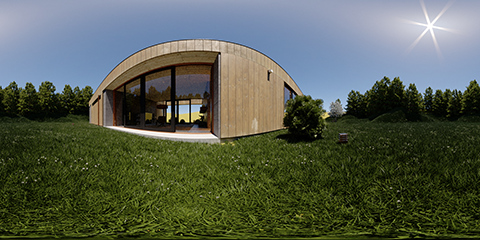
|
Indigo 3.6 brings several new, production-oriented features to the table, while improving on the core features that make Indigo great. Realistic rendering crucially relies on realistic materials, and Indigo 3.6 not only improves on the appearance of basic materials but goes a step further, with additional flexibility and useful new material types. New compositing features have been introduced which are particularly valuable for architectural and product visualisation, and represent a continuing dedication to improving Indigo for existing customers: these upgrades, along with bug fixes and usability improvements, are free for all Indigo 3.x customers. |

|
|
|
Compositing features have been significantly upgraded in Indigo 3.6, with enhanced support for alpha output and a new shadow-catcher rendering mode that makes many product visualisation renders a snap. Alpha export works much better with glass objects, allowing for easy compositing of buildings with glass façades against skyline photography. The new shadow catcher material makes rendering objects resting on the ground a simple matter, with a specialised pass to produce a perfect, ready-to-use alpha PNG layer. |
    Honda CR-Z scene by Arthur Staschyk |

|
|
|
Indigo 3.6 introduces several new material types and options for greater flexibility in material creation. The Coating material simulates a thin, smooth coating on top of a base material, which can be useful for adding shininess to surfaces, from wooden floors and car paints to wet concrete. The Double-sided Thin material is especially useful for realistically modelling leaves, which reflect light differently on the top and bottom sides, and have a degree of scattering through them. Creating stunningly realistic foliage using this material is straightforward, and it is well documented in the online manual. The behaviour of the Phong glossy coating has also been improved to better match the physical appearance and energy conservation of coated materials; the result is more realistic renders, without having to touch any settings. |

|
|
|
Objects can now be made invisible to direct viewing from the camera. They still cast shadows and interact normally with any other light, except they can't be seen directly by the camera. It can be used to make invisible light sources or to peek through walls without creating unrealistic lighting situations. |
  AM V12 Vantage scene by Oscar Johansson |

|
|
|
Another very useful new capability in Indigo 3.6 is rendering with spherical cameras to produce high quality panorama images in standard latitude-longitude format. This can be used either to create new HDR environment maps from your scenes, or with an interactive panorama viewer to allow realtime 360 degree viewing. |

|
|
|
Indigo's integration with 3ds Max (via IndigoMax) has been tremendously improved since Indigo 3.4, with many bug fixes, workflow improvements and Indigo features supported. IndigoMax directly integrates Indigo's rendering into 3ds Max and works entirely in memory, so you don't have to wait for your hard drive during a scene export or material preview, greatly accelerating the modelling process. Scene changes are immediately reflected in the render output with the Interactive rendering mode, which is a great productivity enhancer if you are making many small changes quickly. |

|
|
|
Thanks to tremendous improvements in Revit 2014's addin system, Indigo can now access detailed material descriptions for much more accurate material conversion, without any user effort! Grass scattering is a particularly nice new feature in this release, that makes spreading realistic 3D grass in your scenes a snap: simply select the grass materials in your scene, and it happens automatically on export. Support for IES lights in Revit has also been greatly improved, allowing you to use many realistically modelled light sources in your scenes. |

Besides the many improvements and fixes in this 3.6 release, we have been working on other exciting new features which will be available in upcoming beta releases!
Object scattering is a very useful feature for distributing many object instances over a surface, which dramatically speeds up creating many instances, for example trees in a forest.
A new architectural glass material massively improves convergence speed in typical interior settings.
The Metropolis Light Transport implementation has been greatly improved too, producing much cleaner renders for the same rendering time. Further work on this will make the performance gain even more pronounced.
Subsurface scattering (SSS) has been optimised, resulting in 2x faster rendering in scenes with heavy scattering.

|
Indigo 3.6 is free for Indigo 3.0 owners, and is available on Windows, Mac OS X and Linux, with exporters for Sketchup, 3ds Max, Revit, Blender, Cinema 4D, and Maya. Please contact sales@indigorenderer.com for sales enquiries, or contact@indigorenderer.com for general enquiries. |









